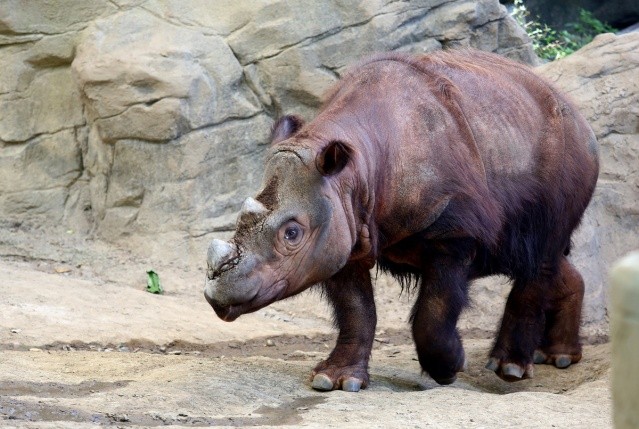Popular Reads
Top Results
Can't find what you're looking for?
View all search resultsPopular Reads
Top Results
Can't find what you're looking for?
View all search resultsSumatran rhino: A real threat of extinction in sight
About a month ago, an extremely rare ten-year-old female Sumatran rhino was captured in East Kalimantan province through a pit trap.
Change text size
Gift Premium Articles
to Anyone
 Harapan, a Sumatran rhino enters his Wildlife Canyon at the Cincinnati Zoo and Botanical Gardens Tuesday in Cincinnati. Harapan, or "Harry" the only Sumatran rhino in the Western Hemisphere, one of three calves born at the Cincinnati Zoo will be moved to Indonesia, to breed at the Sumatran Rhino Sanctuary. (Cara Owsley /The Cincinnati Enquirer via AP)
Harapan, a Sumatran rhino enters his Wildlife Canyon at the Cincinnati Zoo and Botanical Gardens Tuesday in Cincinnati. Harapan, or "Harry" the only Sumatran rhino in the Western Hemisphere, one of three calves born at the Cincinnati Zoo will be moved to Indonesia, to breed at the Sumatran Rhino Sanctuary. (Cara Owsley /The Cincinnati Enquirer via AP)
About a month ago, an extremely rare ten-year-old female Sumatran rhino was captured in East Kalimantan province through a pit trap.
The area that she was captured in was close to mining operations and plantations, an area where the environment was stripped down to its bare essentials and taken over by human activity. It is hard to image a wild animal living there in the middle of that mess. The rhino must have been striving to survive before its capture.
The Sumatran rhino is listed as critically endangered with real numbers in the wild unknown. They were thought to be extinct until 2013, when rhino tracks were discovered by researchers working in Kalimantan rainforests.
The World Wildlife Fund (WWF) has concluded that there are less than 100 Sumatran rhinos alive in the world, their numbers concentrated in Kalimantan. There were also several camera traps that captured pictures of the animals.
So we know that Sumatran rhinos exist, but there haven’t been any real sightings by a person in the last forty years.
The rare female Sumatran rhino was named Najaq a few days later. The world had high hopes for her and the possible survival of her species, and people debated whether to relocate her to a safer area or to bring her to an official rhino sanctuary.
There were lots of plans made for her, including breeding her with Harapan, the only male captive Sumatran rhino.
The idea is to slowly develop a breeding program that can breed the Sumatran rhino back from the brick of extinction. It actually can happen in the space of a few years, with new calves and a gradually increasing count in the rhino population.
Unfortunately, Rhinos are very slow breeders. Female rhinos mature and can breed at the age of six, and can only produce one calf at a time—only once every three to four years. Najaq was first thought to be five, but was confirmed to be ten-years-old through her teeth marks. She was a perfect candidate for the breeding programs.
But sadly, it couldn’t happen.
On April 5, the Sumatran rhino was found dead in her small makeshift enclosure because of an infection in her leg that eventually led to her death after a sudden deterioration of her health. There is now a good deal of grief and disappointment in the world.
Why did she die? Najaq was snared around the leg by a poacher’s trap for quite some time as she roamed wild. The wound eventually led to an infection that caused her death due to some materials of the snare still stuck in her leg that became a poisonous foreign object inside her body.
Although it was reported that her health was improving, her health suddenly plummeted. The news is already a public thing, having spread across the globe. She died because of a careless human who wanted to do business, fully aware of the current state of the animals in the rainforests.
There is still hope for the survival of the Sumatran rhinos, but only if poachers leave the Indonesian rainforests alone. The government is currently trying to stop the rhino horn trade, which happens—regrettably—too often in countries like China.
Let’s face it. There is nothing magical at all in the horn of a rhino. It’s a useless ingredient for the so called “medicine”. It is just a lump of keratin, the same material that grows in the nails of humans.
Extinction is threatening many species in the world. It threatens the tigers and the leopards and it is looming right in front of the rhinos. Extinction is not something that can be called back—it’s permanent. If poachers continue trying to capture rhinos to satisfy demand, there is no turning back. The critical status of the rhino will damage the entire ecosystem. Where will the destruction take us?
The rhino died because of human activity, something that many people believed could not happen. After all, humans believe that nature is in very good hands - in our hands. But then we fail to properly take care of our natural environment.
Najaq’s death was a hard lesson to everyone on the fragility of life. Once an ecosystem slowly dies, nature evolves, with or without us.
People tend to present nature as something that is disconnected from us. But guess what, nature does not need people. It is people who need nature. It is people who totally depend on nature.
Najaq is just the beginning. Over the coming years, there will be several Sumatran rhinos that will be captured by humans, one way or another, in the rainforests of Indonesia. Their lives should not rest in the wrong hands.
It’s not just an individual rhino, it is the whole species that is at stake. It could disappear, like many others, or it could survive for generations to come.
***
Thirteen-year-old Elysa Ng has many interests, including life sciences and literature. During her spare time, she enjoys watching NatGeo Wild, reading Nautilus and playing violin. Online, she can be found at https://elysafaithng.wordpress.com/.
---------------
Interested to write for Youth channel at thejakartapost.com? We are looking for information and opinions from students with appropriate writing skills. The content must be original on the following topics: passion, leadership, school, lifestyle (beauty, fashion, food), entertainment, science & technology, health, social media, and sports. Send your piece to community@jakpost.com, subject: YOUTH.






